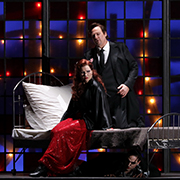Alongside Gounod's “Faust”, Bizet's “Carmen” and Saint-Saëns' “Samson et Dalila”, “Thaïs” by Jules Massenet is one of those 19th-century French operatic masterpieces whose success on the stage remains undiminished to this day. Together with “Manon” (1884) and “Werther” (1892), it is also one of the composer's most popular and original works. This new edition which appears as part of the “L'Opéra français” series enables all three versions of “Thais” to be drawn upon for the first time.
Its originality is due in particular to its subject, inspired by a philosophical novel by Anatole France, which depicts the encounter between the monk Athanaël and the courtesan Thaïs in Alexandria in the 4th century. Starting with the lives of Egyptian monks, it narrates the inner drama of the two protagonists, torn between spiritual and carnal love. This introspective direction of the work is further underlined by numerous episodes of dreams or erotic, mystical or nightmarish visions in the form of extended orchestral passages which are sometimes accompanied by pantomimes or incidental ballets. The most famous of these is undoubtedly the Meditation for solo violin, (chorus) and orchestra, often performed separately in concerts. In technical terms, Thaïs was one of the first French operas to be composed to a prose libretto, not in verse as was previously the norm, a decision which led to a specific type of prosody which lent the work a more free-flowing form.
The score of Thaïs exists in three versions authorised by Massenet, which at times were performed concurrently at different opera houses. The first version from the premiere at the Paris Opera on 16 March 1894 corresponds with the composer’s autograph manuscript and the first editions submitted to the dépot legal. The music has an original and innovative form, with a strong emphasis on symphonic passages, pantomime and dance. After a short first act (La Thébaïde) the second act comprises three continuous scenes linked by two orchestral episodes: Les Amours d'Aphrodite and La Méditation. The third act similarly comprises three scenes, the central one of which is a grand allegorical ballet (La Tentation) which portrays the temptations of the monk Athanaël. In the tradition of Gounod’s Faust, the opera ends with a grand mystic apotheosis.
Despite its musical qualities, praised by the press, the work initially only achieved moderate success: the sequence of scenes without breaks was unlike the performance tradition the Parisian audience was used to – an audience which may well also have been confused by the obligatory dance interludes by the Académie nationale de musique, which Gallet, Massenet and the choreographer Joseph Hansen had conceived as an action ballet strongly characterized by symbolism.
In order to keep his work in the repertoire, straight away after the initial performances in April 1894, Massenet decided to cut the ballet in Act III, to divide the first four scenes equally between Acts I and II, and as a result, to transform Les Amours d'Aphrodite into a prelude to the new Act II and to cut the final apotheosis. From then onwards the opera was performed in this second, revised and shortened version in Paris, most of the provincial theatres and abroad. As the work was now too short for the requirements of the Académie nationale, performances of Thaïs were supplemented by an independent ballet, usually La Korrigane (1881) by Charles-Marie Widor.
In 1898 Massenet revised his work once more, adapting the score to the traditions of the Opéra. He definitively cut Les Amours d'Aphrodite, introduced a new oriental-style ballet more in keeping with public taste at the end of the Act II, as well as a new tableau (L’Oasis), thus bringing Act III better in balance once again. It was in this third version that the work really became established (with or without the ballet).
The first critical edition of Thaïs aims to provide performers and scholars with the complete musical material required for a reconstruction of all three versions of the opera authorised by Massenet. In particular, by integrating the cut passages and scenes, such as the symphony Les Amours d'Aphrodite (Act II), the ballet La Tentation (Act III) and the final apotheosis (Act III), the new edition enables the innovative first version of March 1894 to be restored for the first time.
The new edition has been created based on editions of the full score and vocal score published by Heugel in 1894 and 1898, carefully collated from Massenet’s manuscripts, the provisional engraved score used for the rehearsals and the first performances, and historic material which is preserved in the Bibliothèque-musée of the Opera in Paris.
Fabien Guilloux
(June 2021)
(translation: Elizabeth Robinson)



